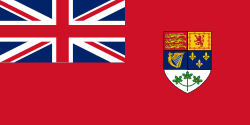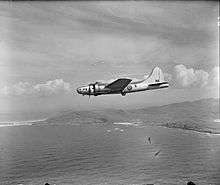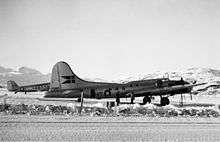List of Boeing B-17 Flying Fortress operators
- This transport-related list is incomplete; you can help by expanding it.
 |
 |
This list of Boeing B-17 Flying Fortress operators is a list of users who flew and operated the Boeing B-17.
The B-17 was among the first mass-produced four-engined heavy bombers. A total of more than 12,000 were made, making its use as a heavy bomber second only to the B-24 Liberator. Though used at some point in all theatres of World War II, it was most common in the European Theatre, where its lack of range and smaller bombload relative to other heavy bombers was not so detrimental as it was in the Pacific, where most American military airbases were thousands of miles apart.
Military operators
 Brazil
Brazil
Brazil acquired 13 B-17s in 1951, according to the Rio Pact of 1947. They were used by the 1º and 2º Esquadrões (1st and 2nd Squadrons) of 6º Grupo de Aviação (6th Aviation Group), based at Recife, for search and rescue and photo-reconnaissance until 1968.[1]
- 6º Grupo de Aviação
- 1º Esquadrão
- 2º Esquadrão
 Canada
Canada
Canada received six Flying Fortresses (three B-17Es and three B-17Fs) which flew 240 trans-Atlantic mail flights from Canada to Canadian troops serving in Europe from 6 December 1943 to 27 December 1946. All six belonged to no. 168 Heavy Transport Squadron which operated out of RCAF Station Rockcliffe, Ontario.[2]
- No. 168 Heavy Transport Squadron
 Colombia
Colombia
 Denmark
Denmark
Danish airline DDL bought two B-17s from Sweden in 1945.[3] One of these planes was transferred to the Danish Army Air Corps in 1948. In 1949, it was transferred to the Royal Danish Navy and in 1952 to the Royal Danish Air Force.[4]
 Dominican Republic
Dominican Republic
Dominican Republic Air Force acquired two B-17Gs in 1947, remaining in use until 1954.[1]
 France
France
French Air Force used one B-17F as an executive transport for Free-French General Marie Pierre Kœnig.[1]
.svg.png) Germany
Germany

During World War II, after crash-landing or being forced down, approximately 40 B-17s were repaired and put back into the air by the Luftwaffe. These captured aircraft were codenamed "Dornier Do 200", given German markings and used for clandestine spy and reconnaissance missions by the Luftwaffe - most often used by the Luftwaffe unit known as KG 200, hence a likely possibility as a source for the "Do 200" codename.[5]
 Israel
Israel
When Israel achieved statehood in 1948, the Israeli Air Force had to be assembled quickly to defend the new nation from the war it found itself almost immediately embroiled in. Among the first aircraft acquired by the Israeli Air Force were three surplus American B-17s, smuggled via South America and Czechoslovakia to avoid an arms trading ban imposed by the United States. A fourth plane was abandoned due to malfunctions and confiscated by American officials. On their delivery flight from Europe, in retaliation for Egyptian bombing raids on Tel-Aviv, the aircraft were ordered to bomb King Farouk's Royal Palace in Cairo before continuing to Israel. They performed the mission (despite some of the crew fainting due to defective oxygen equipment), but caused little damage. The B-17s were generally unsuitable for the needs of the Israeli Air Force, and the nature of the conflict in which long-range bombing raids on large area targets were relatively unimportant—although the psychological impact of the raids was not lost on the enemy. The aircraft were mainly used in the 1948 Arab-Israeli War, flown by 69 Squadron; they were withdrawn in 1958 after seeing minor action in the 1956 Suez Crisis.[6][7]
 Japan
Japan

At least three early versions B-17s (2 B-17Ds and early B-17E) were captured by the Japanese in the Philippines and Netherlands East Indies. Planes were tested by the IJAAF Koku Gijutsu Kenkyujo (Air Technical Research Laboratory) at Tachikawa.
 Nicaragua
Nicaragua
The B-17s were used during the occupation of Nicaragua against the Sandinista National Liberation Front (Frente Sandinista de Liberación Nacional)
 Peru
Peru
 Portugal
Portugal
Força Aérea Portuguesa (Portuguese Air Force) operated five SB-17Gs as search-and-rescue planes from 1947 to 1960.[1]
.svg.png) Soviet Union
Soviet Union
Late in World War II, RAF and USAAF bombers that had been damaged in raids over the Reich would put down in Soviet-controlled territory rather than try to make it back to Western bases, and in April 1945 the Soviet Air Force issued a directive to its units in the field to report the location of any aircraft of its Western Allies that were in Soviet hands; among the aircraft salvaged were a total of 73 B-17s. The Fortresses that were in the best condition were returned to the USAAF, but a number were retained as interim heavy bombers. Although Russian aircrews and maintenance crews had no experience with such aircraft, the Soviets proved ingenious at keeping them flying, and in fact were delighted with the B-17's handling, comparing it to a "swallow" and the nimble Po-2 biplane trainer. On the other hand, Soviet officials tended to order the "filthy pictures" applied to the aircraft removed or painted out. The B-17s remained in service until 1948, when the Tupolev Tu-4 began to arrive at operational squadrons.[8]
 Republic of China
Republic of China
Beginning in 1952, Republic of China (under the guise of the CIA's Civil Air Transport (CAT) and Technical Research Group (TRG) organizations, operated a number of "enhanced" B-17s (with as many as 14 crewmembers at a time) on surveillance and related flights of mainland China. These were crewed by Chinese crews, largely and wore Nationalist Chinese markings. At least one B-17 was shot down by a MiG-15 over mainland China.
 United Kingdom
United Kingdom

The Royal Air Force received 20 B-17Cs, giving them the service name Fortress I, in early 1940 from USAAC. By September, after the RAF had lost eight B-17Cs in combat or to accidents, RAF Bomber Command had abandoned daylight bombing, due to their poor performance. The RAF transferred its remaining Fortress I aircraft to RAF Coastal Command for use as very long range patrol aircraft. These were later augmented in August 1942 by 19 Fortress Mk II and 45 Fortress Mk IIA (B-17F and B-17E, respectively).[9] From 1944 the Fortress IIs and IIIs were being used by the specialist electronic countermeasures squadrons of No. 100 Group RAF
- Royal Air Force
- No. 59 Squadron RAF
- No. 90 Squadron RAF - from 7 May 1941 alongside Bristol Blenheim.
- No. 206 Squadron RAF - July 42- April 44
- No. 214 Squadron RAF
- No. 220 Squadron RAF
- No. 223 Squadron RAF
- No. 251 Squadron RAF
- No. 517 Squadron RAF
- No. 519 Squadron RAF
- No. 521 Squadron RAF
 United States
United States
- See B-17 Flying Fortress units of the United States Army Air Forces
- United States Army Air Corps / United States Army Air Forces
USAAC / USAAF was main operator of all versions of the Boeing B-17 Flying Fortress. Most units operating B-17 were based in the European Theatre of World War II but aircraft was used at some point in all theatres of World War II.
Civil operators
 Bolivia
Bolivia

Used 25 B-17s in civil aviation under different operators.[3]
 Denmark
Denmark
Danish airline DDL bought two B-17s from Sweden in 1945.[3] One of these planes was transferred to the Danish Army Air Corps in 1948.
 France
France
14 B-17 were used between 1946 and 1975 by the French IGN (Institut Géographique National) for aerial photography. One of them is still flying today after restoration as Pink Lady in 2010. It is now on static display à La Ferté-Alais.
.svg.png) Iran
Iran
One of Trans World Airlines B-17G was given to the Shah of Iran in 1947.[3]
 Mexico
Mexico
The Mexican government revived several B-17Gs from the United States for internal policing and anti-mafia operations.
.svg.png) South Africa
South Africa
One B-17G Flying Fortress "44-85718" was registered in South Africa while in service with the Institut Géographique National between 1965 - 1966 performing geographical survey operations. It was registered as ZS-EEC in February 1965 and operated from Pretoria until its return to Creil, France in August 1966. It is currently flying in the United States as Thunderbird with the Lone Star Flight Museum in Galveston, Texas.[10]
Another B-17G "44-8846" was to be registered as ZS-DXM but this was only reserved and not allocated to the aircraft. It is still flying today after restoration as Pink Lady in 2010. It is now on static display à La Ferté-Alais[11]
 Sweden
Sweden

In an exchange with about 300 interned American crew members, nine intact B-17 were given away for free[12] to the Swedish airline SILA (Svensk Interkontinental Lufttrafik AB) to be operated by ABA (which later became part of Scandinavian Airlines System). Seven of these, three B-17F and four B-17G, were converted into 14-seat airliners by Saab Aircraft. By 1946 all were retired and replaced by the DC-4. Today, one of them is on static display at National Museum of the United States Air Force in Dayton, Ohio, restored back to combat figuration.
 United Kingdom
United Kingdom
Two B-17s have been civil registered in the United Kingdom
- G-BEDF Sally B is a B-17G, a former French IGN survey aircraft that operates as a display and memorial aircraft since 1974, originally registered in the United States it became a British civil aircraft in 1984, aircraft is operational with B-17 Preservation Limited from the Imperial War Museum airfield at Duxford as Sally B.[13]
- G-FORT was a B-17G, a former French IGN survey aircraft that was based in the United Kingdom from 1984 to 1987 with two private owners,[14] it was sold in the United States and now flies with the Lone Star Flight Museum as Thunderbird.
 United States
United States
.jpg)
- Following the war, Trans World Airlines purchased a surplus B-17G and used it to survey and set up routes in the Middle-East. In 1947, it was given to the Shah of Iran.[3]
- Aero Union - began operation of the B-17 as a fire fighting aircraft in 1961.[15]
See also
References
- 1 2 3 4 Hess and Winchester Wings of Fame 1997, p. 107.
- ↑ Air Force Public Affairs/Department of National Defence (2004). "Canada's Air Force:Boeing B-17 Flying Fortress". www.airforce.forces.gc.ca. Retrieved 16 January 2007.
- 1 2 3 4 5 Baugher, Joe. "B-17 Commercial Transports". Encyclopedia of American Aircraft. Retrieved 15 January 2007.
- ↑ Schrøder, Hans (1991). "Royal Danish Airforce". Ed. Kay S. Nielsen. Tøjhusmuseet, 1991, p. 1–64. ISBN 87-89022-24-6.
- ↑ Law, Ricky. Dornier Do 200. Arsenal of Dictatorship, January 1997. Access date: 13 April 2007.
- ↑ Rozen, Oren. "Israeli Air Force Bombers:Boeing B-17 Flying Fortress". The Israeli Air Force – IDF/AF. Archived from the original on 20 January 2008. Retrieved 24 December 2006.
- ↑ Aloni, Shlomo (October 2006). "The Israeli View". Aeroplane. Vol. 34 no. 10. pp. 70–74.
- ↑ Goebel, Greg (2005). "Fortress Oddballs". The Boeing B-17 Flying Fortress. Retrieved 9 January 2007.
- ↑ Gustin, Emmanuel. "Boeing B-17". uboat.net. Retrieved 2 April 2007.
- ↑ Warbird Resource Group B-17 Registry page http://www.warbirdregistry.org/b17registry/b17-448718.html
- ↑ Warbird Resource Group B-17 Registry page http://www.warbirdregistry.org/b17registry/b17-448846.html
- ↑ Wandehall, Jan (September 1991). "The myth about "A fistful of Dollars"". Kontakt. 103: 32–33.
- ↑ UK Civil Aviation Authority aircraft register - G-BEDF
- ↑ UK Civil Aviation Authority aircraft register - G-FORT
- ↑ P2VNeptune.org
- Sources
- Arakaki, Leatrice R. and John R. Kuborn. 7 December 1941: The Air Force Story. Hickam Air Force Base, Hawaii: Pacific Air Forces, Office of History, 1991. ISBN 0-912799-73-0.
- Birdsall, Steve. The B-17 Flying Fortress. Dallas, Texas: Morgan Aviation Books, 1965.
- Bowers, Peter M. Boeing Aircraft Since 1916. Annapolis, Maryland: Naval Institute Press, 1989. ISBN 0-370-00016-1.
- Bowers, Peter M. Fortress In The Sky, Granada Hills, California: Sentry Books, 1976. ISBN 0-913194-04-2.
- Bowman, Martin W. Castles in the Air: The Story of the B-17 Flying Fortress Crews of the U.S. 8th Air Force. Dulles, Virginia: Potomac Books, 2000. ISBN 1-57488-320-8.
- Caidin, Martin. Black Thursday. New York: E.P. Dutton & Company, 1960. ISBN 0-553-26729-9.
- Caldwell, Donald and Richard Muller. The Luftwaffe over Germany: Defense of the Reich. London: Greenhill Books Publications, 2007. ISBN 978-1-85367-712-0.
- Carey, Brian Todd. "Operation Pointblank: Evolution of Allied Air Doctrine During World War II." World War II, November 1998. Retrieved: 15 January 2007.
- David, Donald. "Boeing Model 299 (B-17 Flying Fortress)." The Encyclopedia of World Aircraft. Etobicoke, Ontario, Canada: Prospero Books, 1997. ISBN 1-85605-375-X.
- Davis, Larry. B-17 in Action. Carrollton, Texas: Squadron/Signal Publications, 1984. ISBN 0-89747-152-0.
- Freeman, Roger A. B-17 Fortress at War. New York: Charles Scribner's Sons, 1977. ISBN 0-684-14872-2.
- Frisbee, John L. "Valor: Courage and Conviction." Air Force Magazine Volume 73, Issue 10, October 1990.
- Hess, William N. B-17 Flying Fortress: Combat and Development History of the Flying Fortress. St. Paul, Minnesota: Motorbook International, 1994. ISBN 0-87938-881-1.
- Hess, William N. B-17 Flying Fortress Units of the MTO. Botley, Oxford, UK: Osprey Publishing Limited, 2003. ISBN 1-84176-580-5.
- Hess, William N. Big Bombers of WWII. Ann Arbor, Michigan: Lowe & B. Hould, 1998. ISBN 0-681-07570-8.
- Hess, William N. and Jim Winchester. ""Boeing B-17 Flying Fortress:Queen of the Skies". Wings Of Fame. Volume 6. London:Aerospace Publishing, 1997. ISBN 1-874023-93-X. ISSN 1361-2034. pp. 38–103.
- Hoffman, Wally and Rouyer, Philipppe. "La guerre à 30 000 pieds" . Louviers : Ysec Editions, 2008. ISBN 978-2-84673-109-6. [Available only in French]
- Jablonski, Edward. Flying Fortress. New York: Doubleday, 1965. ISBN 0-385-03855-0.
- Johnsen, Frederick A. Boeing B-17 Flying Fortress. Stillwater, Minnesota: Voyageur Press, 2001. ISBN 1-58007-052-3.
- Johnsen, Frederick A. "The Making of an Iconic Bomber." Air Force Magazine, Volume 89, Issue 10, 2006. Retrieved: 15 January 2007.
- Lloyd, Alwyn T. B-17 Flying Fortress in Detail and Scale vol.11: Derivatives, part 2. Fallbrook, California: Aero Publishers, 1983. ISBN 0-8168-5021-6.
- Lloyd, Alwyn T. B-17 Flying Fortress in Detail and Scale vol.20: More derivatives, part 3. Blue Ridge Summit, Pennsylvania: Tab Books, 1986. ISBN 0-8168-5029-1.
- Lloyd, Alwyn T. and Terry D. Moore. B-17 Flying Fortress in Detail and Scale vol.1: Production Versions, part 1. Fallbrook, California: Aero Publishers, 1981. ISBN 0-8168-5012-7.
- O'Leary, Michael. Boeing B-17 Flying Fortress (Osprey Production Line to Frontline 2). Botley, Oxford, UK: Osprey Publishing, 1999. ISBN 1-85532-814-3.
- Salecker, Gene Eric. Fortress Against The Sun – The B-17 Flying Fortress in the Pacific. Conshohocken, Pennsylvania: Combined Publishing, 2001. ISBN 1-58097-049-4.
- Thompson, Scott A. Final Cut: The Post War B-17 Flying Fortress, The Survivors: Revised and Updated Edition. Highland County, Ohio: Pictorial Histories Publishing Company, 2000. ISBN 1-57510-077-0.
- Willmott, H.P. B-17 Flying Fortress. London: Bison Books, 1980. ISBN 0-85368-444-8.
- Yenne, Bill. B-17 at War. St Paul, Minnesota: Zenith Imprint, 2006. ISBN 0-7603-2522-7.
External links
| Wikimedia Commons has media related to Boeing B-17. |